Lorsqu'il s'agit d'imprimer des motifs sur des vêtements, la méthode que vous choisissez peut faire toute la différence. It’;il ne s'agit pas seulement d'apposer un logo sur un t-shirt; it’;il s'agit de créer un design qui a fière allure, dure longtemps, and matches your unique vision. ;
That’;s why it’;Il est essentiel de comprendre les deux méthodes d’impression les plus populaires: DTG vs screen printing. ;
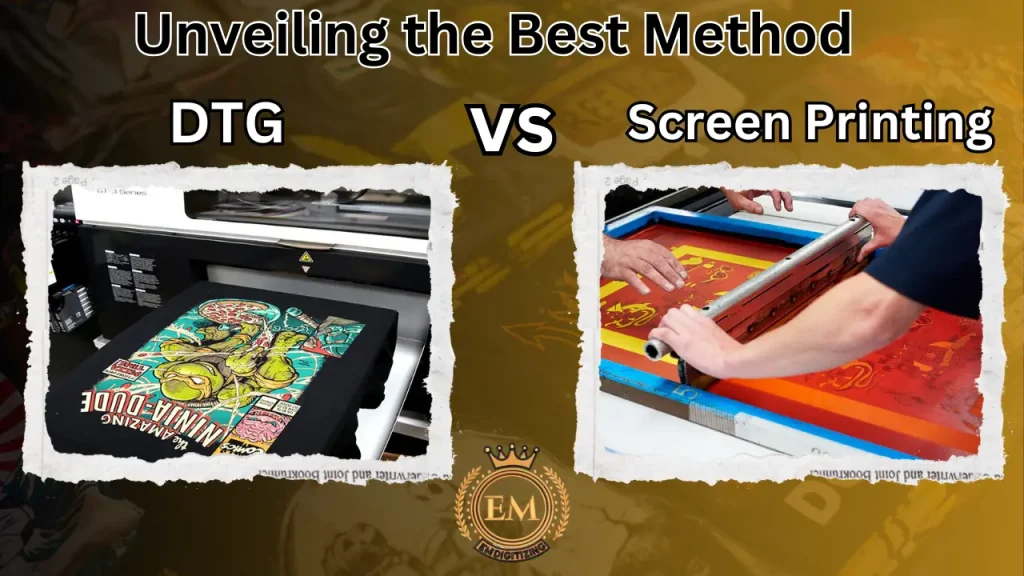
Dans cet article, we’;Je vais plonger dans le monde de ces techniques d'impression, explorez leurs avantages et leurs inconvénients, et vous aider à décider lequel correspond le mieux à vos besoins.
DTG vs sérigraphie: Dévoiler la meilleure méthode
Présentation de l'impression DTG
Directement sur le vêtement (DTG) impression est une méthode d'impression textile moderne qui applique directement de l'encre sur les tissus à l'aide de la technologie jet d'encre.
Comment fonctionne l'impression DTG?
L'impression DTG, c'est comme avoir une imprimante à jet d'encre de haute technologie pour vos vêtements. Il s'agit d'utiliser des imprimantes spécialisées qui appliquent directement de l'encre sur le tissu..
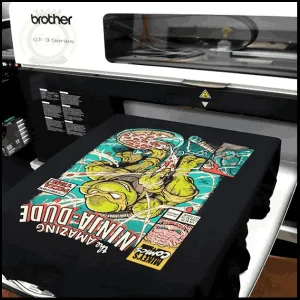
L'imprimante pulvérise avec précision l'encre sur le vêtement, creating vivid and detailed designs. ;Considérez-le comme votre propre chef-d'œuvre portable!
Avantages de l'impression DTG
L'un des plus grands avantages de l'impression DTG est sa capacité à produire des motifs complexes et colorés.. Que vous souhaitiez imprimer une photo ou un logo multicolore, DTG peut le gérer facilement.
Le processus d'impression est également rapide et efficace, ce qui le rend idéal pour les petites séries de production ou les articles personnalisés.
Plus, l'encre utilisée pour l'impression DTG est à base d'eau, résultant en une sensation douce et confortable sur le tissu.
Limites de l'impression DTG
Alors que l'impression DTG est fantastique pour les conceptions complexes, ce n'est peut-être pas le meilleur choix pour les commandes groupées. Le processus peut prendre du temps et être coûteux pour de plus grandes quantités..
En outre, Le DTG est plus adapté à l'impression sur des tissus de couleur claire, car l'encre peut ne pas apparaître aussi bien sur les matériaux plus foncés. It’;Il convient de noter que l'impression DTG fonctionne mieux sur 100% vêtements en coton, alors gardez cela à l'esprit lorsque vous choisissez votre toile.
Présentation de la sérigraphie
La sérigraphie est une technique ancestrale dans l'industrie textile, connu pour sa polyvalence et sa durabilité dans la production de designs éclatants sur une variété de matériaux.
Comment fonctionne la sérigraphie?
Impression d'écran est l'OG de l'impression de vêtements, et cela implique d'utiliser un pochoir (ou écran) transférer de l'encre sur le tissu.
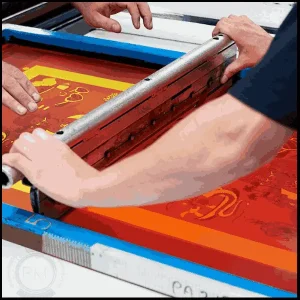
Un écran différent est utilisé pour chaque couleur du design, permettant une superposition précise et des résultats éclatants. It’;C'est une méthode éprouvée qui existe depuis des siècles, et pour cause!
Avantages de la sérigraphie
La sérigraphie offre une durabilité exceptionnelle, ce qui en fait un choix populaire pour les marques de vêtements et les vêtements promotionnels. L'encre utilisée est généralement plus épaisse et plus résistante à la décoloration., résultant en une impression plus durable.
It’;C'est également une excellente option pour imprimer sur des vêtements de couleur foncée, car les couleurs peuvent facilement apparaître sur le tissu.. If you’;je planifie une grande série de chemises, la sérigraphie est souvent plus rentable que le DTG.
Limites de la sérigraphie
Alors que la sérigraphie peut traiter de grandes quantités, it’;n'est pas aussi adapté aux designs complexes avec de nombreuses couleurs ou des détails fins. Chaque couleur nécessite un écran séparé, ce qui peut devenir long et coûteux pour des œuvres d'art complexes.
En outre, la sérigraphie peut donner une impression légèrement plus épaisse, qui pourrait ne pas être aussi doux au toucher que le DTG. Mais bon, certaines personnes aiment un peu de texture dans leurs t-shirts!
Facteurs à considérer: Comparaison DTG et sérigraphie
En comparant les coûts, qualité, et délai d'exécution, it’;Il est essentiel de trouver un équilibre entre ces facteurs cruciaux.
Comparaison des coûts
Quand il s'agit de coût, il y a quelques facteurs à considérer. L'impression DTG a tendance à être plus abordable pour les petites quantités, tandis que la sérigraphie devient plus rentable pour les commandes plus importantes.
La complexité de la conception peut également avoir un impact sur le prix, car la sérigraphie nécessite des écrans séparés pour chaque couleur. En fin de compte, it’;Il est essentiel de peser les coûts initiaux par rapport à la quantité souhaitée et à la complexité de la conception..
Comparaison de la qualité de la sérigraphie et du DTG
La sérigraphie et la DTG peuvent produire des résultats de haute qualité, mais ils ont des caractéristiques légèrement différentes. L'impression DTG excelle dans la reproduction de motifs complexes et de couleurs éclatantes.

tandis que la sérigraphie offre une durabilité et une opacité exceptionnelles sur les tissus foncés. Réfléchissez à ce qui compte le plus pour vous et votre marque: esthétique accrocheuse ou tenue longue durée?
Comparaison des délais d'exécution
Quand il s'agit de délais d'exécution, L'impression DTG remporte la couronne. It’;c'est un processus plus rapide, surtout pour les petites commandes, as there’;pas besoin de créer des écrans ou de configuration approfondie.
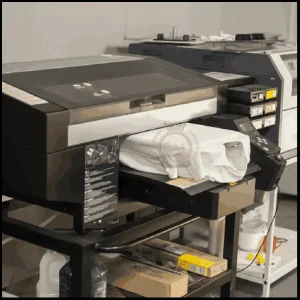
Impression d'écran, d'autre part, peut nécessiter plus de temps pour préparation des œuvres d'art et séparation des couleurs. Si la rapidité est cruciale pour votre projet, DTG est la voie à suivre.
Durabilité et lavabilité: Évaluation de la longévité des vêtements DTG par rapport aux vêtements sérigraphiés
Quand il s'agit de durabilité et de lavabilité, la sérigraphie DTG et la sérigraphie ont leurs avantages et leurs inconvénients.
Impression d'écran, la méthode éprouvée, utilise d'épaisses couches d'encre qui durcissent sur le tissu, résultant en un design dynamique et durable.
Ces impressions peuvent résister à plusieurs lavages sans décoloration ni fissure significative., ce qui en fait un choix populaire pour les vêtements qui doivent résister à l'usure régulière.
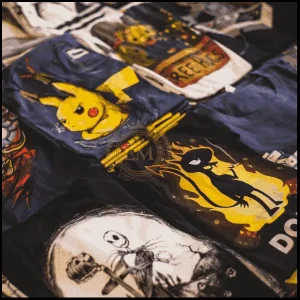
D'autre part, L'impression DTG consiste à imprimer numériquement le motif directement sur le vêtement à l'aide d'une technologie jet d'encre spécialisée..
Même si les impressions DTG résistent également au lavage, ils ne sont peut-être pas aussi durables que les sérigraphies, surtout si le vêtement est soumis à des lavages fréquents et agressifs. Au fil du temps, les couleurs des impressions DTG peuvent s'estomper légèrement ou montrer des signes d'usure.
En fin de compte, la durabilité et la lavabilité de vos vêtements imprimés dépendront de divers facteurs, comme la qualité de l'encre et du tissu, instructions d'entretien appropriées, et à quelle fréquence comptez-vous les laver.
Si la longévité est une priorité absolue, la sérigraphie peut être la meilleure option pour vous.
Complexité de conception: Évaluation de l'adéquation des conceptions complexes
Lorsqu'il s'agit de designs complexes, L'impression DTG remporte la couronne. Sa nature numérique permet des impressions précises et détaillées, ce qui en fait le choix idéal pour les œuvres d'art complexes, photographies, ou des designs présentant des motifs et des ombres complexes.
Impression d'écran, d'autre part, repose sur un processus de type pochoir dans lequel chaque couleur du dessin nécessite un écran séparé.
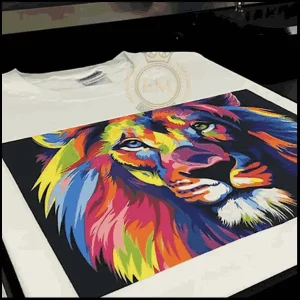
Cela peut rendre difficile l'obtention de détails fins, dégradés, or small text without compromising the design’;la clarté. Même si la sérigraphie peut encore produire des résultats impressionnants, ce n'est peut-être pas le meilleur choix pour les conceptions qui exigent une précision complexe.
Si votre design présente des lignes fines, détails délicats, ou des images photoréalistes, L'impression DTG vous donnera les meilleurs résultats. Cependant, si votre conception est plus simple ou utilise du gras, couleurs unies, la sérigraphie peut toujours offrir une excellente qualité.
Impact environnemental: Analyser la durabilité du DTG par rapport à la sérigraphie
Let’;Je parle de l'éléphant dans la salle d'impression: l'impact environnemental. En termes de durabilité, L'impression DTG présente un net avantage par rapport à la sérigraphie.
L'impression DTG minimise les déchets en utilisant uniquement la quantité d'encre nécessaire pour chaque motif spécifique.. It doesn’;ne nécessite pas d'écrans ou d'autres configurations physiques, ce qui signifie qu'aucun produit chimique ni consommation excessive d'eau n'est impliqué dans le processus d'impression.
Cela en fait une option plus respectueuse de l’environnement, spécialement pour l'impression en petits lots ou à la demande.
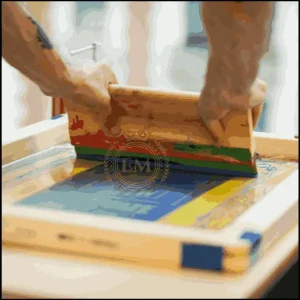
D'autre part, la sérigraphie implique l'utilisation d'écrans, émulsions, et produits chimiques, ce qui peut entraîner davantage de déchets et de pollution. En outre, le processus de nettoyage pour la sérigraphie nécessite beaucoup plus d'eau que l'impression DTG.
Bien qu'il existe des pratiques respectueuses de l'environnement et produits disponibles pour la sérigraphie, comme les encres à base d'eau et les méthodes de nettoyage respectueuses de l'environnement, L'impression DTG a généralement une empreinte écologique plus faible.
Conclusion: Déterminer la meilleure méthode pour vos besoins d'impression
Dans la bataille entre DTG et sérigraphie, il n'y a pas de gagnant définitif. Les deux méthodes ont leurs forces et leurs faiblesses, la prise de décision dépend en fin de compte de vos besoins d'impression spécifiques.
Si la durabilité et la lavabilité sont cruciales, en particulier pour les vêtements qui subiront des lavages fréquents ou un usage intensif, la sérigraphie est la voie à suivre. Ses couches d'encre plus épaisses et son processus de durcissement garantissent une longévité et des couleurs éclatantes qui peuvent résister à l'épreuve du temps..
D'autre part, if you’;vous cherchez à imprimer des designs complexes avec des détails fins, L'impression DTG sera votre meilleure amie. Sa technologie numérique permet des impressions précises et complexes qui peuvent capturer chaque nuance de vos œuvres d'art ou photographies..
Pour terminer, si la durabilité est une priorité absolue pour vous, L'impression DTG gagne en termes de gaspillage minimal et de pratiques respectueuses de l'environnement.
EMnumérisation: Expert en numérisation de broderie à votre service
Si vous êtes intéressé par tout type de projet de broderie, alors EMdigitizing est la meilleure option pour vous. Nous offrons numérisation de broderie et des services d'art vectoriel avec un délai d'exécution rapide. Vous pouvez également visiter et consulter notre site Web ainsi que nos meilleurs services.
Nous offrons également un excellent 50% réduction sur tous nos services pour nos nouveaux clients respectés. Nous proposons également des devis gratuits générés en seulement 5 minutes.
Vous devriez profiter de cette offre à durée limitée et faire passer votre projet de broderie au niveau supérieur avec EMdigitizing.
Si vous avez des questions concernant ce sujet, tu peux leur demander. Merci d'avoir pris le temps de lire cet article.
Questions fréquemment posées:
Directement sur le vêtement (DTG) l'impression ne dure généralement pas aussi longtemps que la sérigraphie. Alors que DTG offre des produits de haute qualité, impressions détaillées, la sérigraphie est connue pour sa longévité et sa durabilité dans le temps.
Le DTG peut être plus cher que la sérigraphie pour les grosses commandes en raison de son processus plus lent et des coûts d'encre plus élevés., mais pour les petits lots et les détails complexes, dessins multicolores, Le DTG peut être plus rentable.
DTG fonctionne mieux sur 100% coton car le tissu absorbe bien l'encre, produire des impressions éclatantes et de haute qualité. Cependant, il peut également être utilisé sur les mélanges de coton, mais les résultats peuvent varier.
Les impressions DTG peuvent s'estomper avec le temps, surtout avec des lavages fréquents ou des soins inappropriés, mais les progrès de la technologie des encres ont amélioré leur lavabilité et leur longévité globale.
